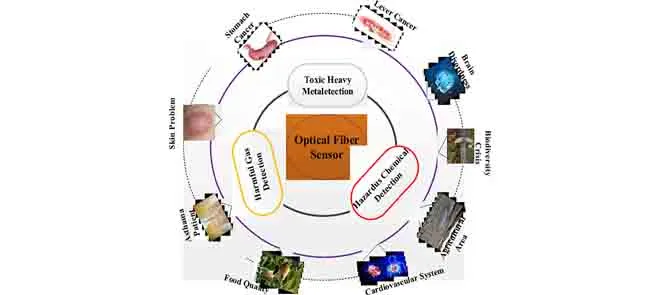Advances in Nanocomposite Thin-Film-Based Optical Fiber Sensors for Environmental Health Monitoring-A Review
Nanocomposite-based optical fiber sensors have gained significance in accurate detection of analytes like harmful chemicals, gasses, bio-analytes, and pollutants due to their heightened sensitivity and real-time monitoring capabilities. They are used in fields like food processing, air quality monitoring, heavy metal removal, and safety applications.
Optical fiber sensors (OFS) outperform older techniques like near-infrared spectroscopy (NIR) because of their robust field interaction, owing to the thin film material they are based on. These materials have a larger surface area, allowing them to form a variety of morphologies. They show great endurance towards high temperatures, humidity, and corrosive gas concentrates, making them suitable for various gas detections, like Ammonia (NH3) and Carbon Dioxide (CO2).
Ammonia is a toxic gas when exposed for more than 15 mins at a 35 ppm concentration that requires constant monitoring due to its risks of causing burning sensations, respiratory issues, and even proving to be fatal. A methylamine hydroiodide-coated ammonia sensor with reconfigured fiber optics uses a halogen light source and a spectrometer to observe ammonia concentration. ZnO-coated optical sensors with Lossy Mode Resonances (LMR) are promising for radiation-based NH3 detection.
Optical fiber sensors measure crucial CO2 levels for patients with respiratory issues. It works by igniting the tip with a halogen light source, and a CCD (Charge Coupled Device) spectrometer then captures the reflected light to observe absorption pattern changes.
The nanomaterials enhance the fiber-optic chemical sensors’ efficiency in detecting ions and pH changes. This sensor works by converting chemical analytes into quantifiable signals through interaction with evanescent light streams.
The quality of drinking water deteriorates with the mixing of heavy metals. Total Suspended Particles (TSP) with concentrations less than 45 mg/L weekly are deemed fit for municipal drinking water. OFS employs blue and red light to determine turbidity concentration in toxic analytes like Lead, Copper, and Cadmium ions.
Lead analyte is carcinogenic, leading to kidney and brain damage. The detection compares voltage response in the absence and presence of lead using an αFe2O3/SnO2 coated fiber optic sensor based on SPR (Surface Plasmon Resonance) techniques.
The Optical sensor platform is further developed by modifying the fiber with a 980μm polymethyl methacrylate (PMMA) core for successfully detecting Copper ions by tracking light in the wavelength range of 350 to 1023 nm.
Cadmium (Cd+2) concentrations exceeding 0.129mg/L in the human body can cause several disorders and kidney cancer. Polymeric coumarin dye-coated OFS detects these ions using the MZI (Mach-Zehnder interferometer) sensor, where a splitter divides light into sensing and reference arms. The delay due to the confinement of light detects these target analytes.
Fiber optic sensors, with high sensitivity and miniaturization, are valuable for gas, chemical, and heavy metal monitoring. They excel in hazardous areas in comparison to conventional sensors due to their immunity to electric sparking issues.
OFS based on nanocomposite thin films showcases excellent sensitivity, real-time monitoring, extensive operating range, and cost-effectiveness. The growing applications in health monitoring suggest a promising future for these sensors.




